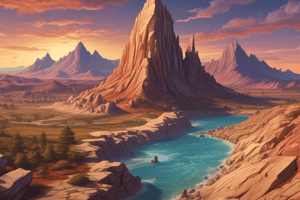Podcast
Questions and Answers
What theory is most widely accepted as the explanation for the inception of the Universe?
What theory is most widely accepted as the explanation for the inception of the Universe?
- The Big Bang Theory (correct)
- The Steady State Theory
- The Oscillating Universe Theory
- The Multiverse Theory
Approximately how long ago did the Earth itself begin to form?
Approximately how long ago did the Earth itself begin to form?
- 6 billion years ago
- 3 billion years ago
- 4.5 billion years ago (correct)
- 2.5 billion years ago
Which early continent was formed after the solidification of cosmic rocks?
Which early continent was formed after the solidification of cosmic rocks?
- Rodinia (correct)
- Laurasia
- Gondwana
- Pangaea
What processes contribute to the dynamic nature of the Earth's surface?
What processes contribute to the dynamic nature of the Earth's surface?
The theories surrounding the formation of the Earth often exhibit a reliance on what?
The theories surrounding the formation of the Earth often exhibit a reliance on what?
What characterized the volume of matter that led to the Big Bang?
What characterized the volume of matter that led to the Big Bang?
What event facilitated the creation of the Earth and its continental structures?
What event facilitated the creation of the Earth and its continental structures?
What is a primary factor influencing the formation of continents?
What is a primary factor influencing the formation of continents?
What marked the formation of Gondwana during the Late Cambrian Period?
What marked the formation of Gondwana during the Late Cambrian Period?
Which four major continents evolved during the Mid-Ordovician Period?
Which four major continents evolved during the Mid-Ordovician Period?
What occurred when Laurasia collided with Baltica in the Mid-Silurian?
What occurred when Laurasia collided with Baltica in the Mid-Silurian?
During which period did the continual collision of land masses lead to the formation of the pre-Pangaea continent?
During which period did the continual collision of land masses lead to the formation of the pre-Pangaea continent?
What major geological event took place around 306 million years ago regarding North America?
What major geological event took place around 306 million years ago regarding North America?
What was the result of the initial break-up of Pangaea during the late Triassic Period?
What was the result of the initial break-up of Pangaea during the late Triassic Period?
During which period did the break-up of Pangaea continue to lead to the separation of tectonic plates?
During which period did the break-up of Pangaea continue to lead to the separation of tectonic plates?
What characterizes the stability of Earth's continents during the Quaternary Period?
What characterizes the stability of Earth's continents during the Quaternary Period?
Flashcards are hidden until you start studying
Study Notes
Formation of Continents and Oceans
- Earth’s formation linked to Solar System development, sharing origins with other celestial bodies.
- Diversity of theories exists regarding Earth and Solar System formation, often speculative and lacking empirical evidence.
- "Big Bang" theory: Universe formed 10 to 20 billion years ago from a dense, hot explosion leading to celestial evolution.
- Earth originated about 4.5 billion years ago from gas and dust around the Sun, with cooling and gravitational processes shaping the planet.
I. Formation of the Earth and Initial Land Masses
- Initial phase (4.6 to 3.9 billion years ago): Solidification of cosmic rocks formed the planet’s foundation.
- Early continent Rodinia emerged post-solidification, representing significant land formation in Earth's history.
II. Development of Supercontinents
- Gondwana: Formed around the South Pole during the Late Cambrian Period (514 Ma), crucial in continental assembly.
- Major continents evolved during the Mid-Ordovician Period (458 Ma):
- Gondwana
- Baltica
- Siberia
- Laurasia
- Mid-Silurian collision (425 Ma): Laurasia collided with Baltica, closing the Iapetus Sea, reflecting a trend of continental collisions.
III. Formation of Pre-Pangaea and Pangaea
- Pre-Pangaea formed during the Early Devonian Period (approximately 390 Ma) from continuous land mass collisions.
- Development of North America occurred in the Late Carboniferous Period (306 Ma) through geological formations.
- Pangaea emerged (255 to 210 Ma), marking the peak of continental convergence, comprising most landmasses.
IV. Break-up of Pangaea
- Initial breakup of Pangaea started in the late Triassic Period (210 to 180 Ma):
- Split into Laurasia (north) and Gondwana (south).
- Late Cretaceous Period saw continued fragmentation, leading to larger oceanic bodies as continents drifted apart; North America began distancing from Africa.
V. Modern Configuration of Continents
- Tertiary Period: Continued continental drift characterized ongoing tectonic plate shifts, gradually approaching modern configurations.
- Quaternary Period marks significant stability, with Earth's continents largely retaining their current positions.
Studying That Suits You
Use AI to generate personalized quizzes and flashcards to suit your learning preferences.




